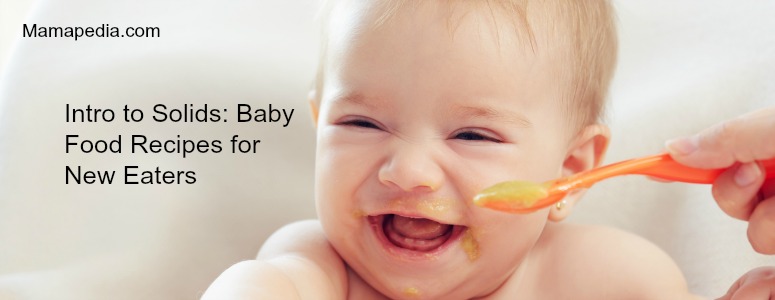
Intro to Solids: Baby Food Recipes for New Eaters
Introducing your baby to solids is an exciting time, but not one to rush. “The American Academy of Pediatrics recommends 6 months of age as a good time to start with solid foods,” explains registered dietitian, Colette Raymond of Colorado Springs, Colorado.
Single-grain cereals are often recommended as the very first tastes. These provide necessary iron and can be mixed with breast milk or formula to a thin consistency to help baby adapt. “A good rule of thumb is to start a new food one at a time, to help rule out allergies,” says Raymond. Give her three to seven days to get used to the taste of each new food and for you to see if she has any reactions.
Remember that your baby should be getting the bulk of her nutrients and calories from breastmilk and/or formula until she’s 12 months of age, so don’t stress if she doesn’t eat more than a few bites of solid food.
Making your own baby food is simple. Bust out your blender or food processor to make the following foods the right, smooth consistency for your baby. Avoid adding sugar to any of these foods; she doesn’t need it.
Iron-Rich: “Between the ages of four to six months, breast-fed babies need iron supplementation, so a good first food could be vegetables high in iron, like split peas and spinach,” suggests Raymond.
To prepare the vegetables, cook them until soft and then puree with a hand blender; add small amounts of water until you get the consistency that’s right for your baby’s age. Note that split peas may need several hours of cooking to get to a super soft consistency that can be pureed. No need to add salt.
Fruity Tastes: Most babies react positively to the naturally sweet taste of fruit purees. Cook peeled, chopped chunks of harder fruits, such as apples and pears, in boiling water until the flesh is soft. Then, puree with a few drops of water to thin out the texture. Always cool the puree before giving to your baby.
Bananas and avocados are examples of naturally soft fruits that you can puree without cooking first.
Once you’ve given your baby a taste of several single fruits, consider combining flavors. Examples of tasty mixes include mango and apple or peach and banana. You’ll still need to cook down the harder fruit to get a super smooth puree. Fruit and veggie purees also taste good to baby, such as carrot and mango or butternut squash and apple.
Mashed Foods: Save mashed foods for until after your baby has mastered purees and your doctor says it’s OK for him to move to chunkier bites – usually around 9 months to 1 year. When you do add mashes, introduce ground meats and soft rice. You might also offer some casserole foods, such as a soft pasta with tomato sauce and mashed peas.
And don’t worry if your baby doesn’t like something you serve. “Keep trying. Babies usually need to try a new food a few times before they like it,” assures Raymond.
Andrea Cespedes is a professionally trained chef and a Certified Nutrition Therapist. With more than 20 years of experience in the fitness industry, she coaches cycling and running and teaches Pilates and yoga. She is an American Council on Exercise-certified personal trainer, RYT-200 and has degrees from Princeton and Columbia University. She’s the proud mom of two kids, who love dance, rock climbing and animals.